|
||||||||||
|
|
||||||||||
|
||||||||||
|
|
||||||||||
It is also a common misconception that the Challenger "exploded." In actuality, the Shuttle was destroyed by a structural failure that caused the vehicle to break apart. As the vehicle disintegrated, it released large amounts of fuel that vaporized to form a massive cloud surrounding the Shuttle. The expansion of this cloud is what has created the perception of an explosion.
Parts of the Shuttle:
To understand how the catastrophe occurred, we first need to take a moment to explain the various components of the Space Shuttle and how they work. The Shuttle, officially known as the Space Transportation System (STS), is made up of three major pieces--the Orbiter, External Tank (ET), and two Solid Rocket Booster (SRB) motors--as illustrated below.
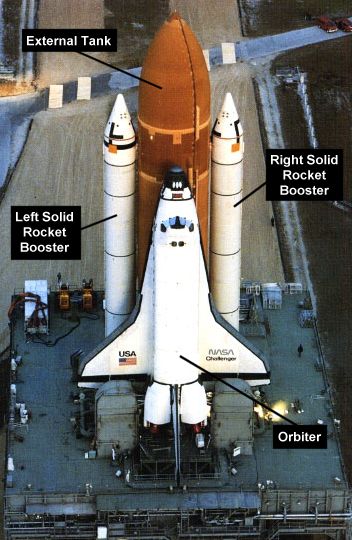
The primary component of the vehicle is the Orbiter, the reusable, winged craft containing the crew and payload that actually travels into space and returns to land on a runway. However, the Orbiter alone does not generate enough thrust or carry enough fuel to get into orbit. The additional thrust is provided by the two large Solid Rocket Boosters, each attached to the side of the External Tank by means of two struts. These two powerful rocket motors are made of several segments containing solid fuel and surrounded by a metal casing.
The segments of each booster are joined into three major sections at the factory and shipped to the Vehicle Assembly Building at NASA Kennedy Space Flight Center in Florida. Here, the three sections are joined together during Shuttle assembly, and the field joints between the segments contain two rubber O-rings. Under the heat generated by the burning propellant within the boosters, these rubber seals expand to fill the field joints and prevent the hot exhaust from escaping.
The two SRBs provide the majority of the thrust needed to propel the Shuttle into orbit. Although solid rockets are less complex and cheaper than liquid-fuel rocket engines, like those used on the Orbiter itself, their primary disdvantage is that they cannot be throttled or turned off. Once ignited, the SRBs continue to burn full force until they exhaust their fuel supply. After they have performed their job and lifted the Shuttle to an altitude of about 150,000 ft (45,760 m), the SRBs are jettisoned using small explosive charges. The SRBs then deploy parachutes and fall into the ocean. Here, they are recovered by tugboats that tow the boosters back to shore to be refurbished for use on a future flight.
The purpose of the External Tank, the single largest piece of the STS, is to carry the liquid fuel needed by the three main engines located in the aft section of the Orbiter. In addition to the SRBs, these three liquid fuel engines provide the thrust needed to reach orbit. The main engines require a large amount of liquid propellant over the nearly nine minutes they are in operation. This propellant is carried within the External Tank. The lower two-thirds of the tank is filled with liquid hydrogen while the upper third contains liquid oxygen.
These cryogenically-cooled propellants are loaded into the ET several hours before flight through a system of pipes located in the launch pad complex. During launch, the liquid propellants are fed into the Orbiter to supply the three main engines until about 8 1/2 minutes after liftoff. At this point, the Shuttle reaches Main Engine Cutoff (MECO) and the ET's supply of fuel is exhausted. The ET is jettisoned from the Orbiter at an altitude of about 365,000 ft (111,355 m). Being the only non-reusable part of the STS, the tank falls back to Earth and burns up over the Indian Ocean.
Cold Temperatures:
Understanding these various parts of the Shuttle system now allows us to see what went so horribly wrong in the Challenger disaster. The prevailing theory, as laid out by the investigations into the tragedy, is that neither the primary nor secondary O-rings properly sealed what is known as the aft field joint in the right SRB. This joint is located near the lower strut connecting the SRB to the External Tank. The failure of the O-rings allowed hot 6,000°F (3,315°C) exhaust gases from inside the rocket motor chamber to escape and led to a cataclysmic chain of events.
Most sources cite the fact that the air temperature had dropped to 18°F (-8°C) the night before and 36°F (2°C) on the morning of the launch. No previous flight had been attempted below 51°F (11°C), and the manufacturer, Morton Thiokol, had insufficient data on how the boosters would perform at lower temperatures. Although Thiokol engineers were concerned about launching under these conditions and recommended a delay, many felt that the boosters should be able to operate safely even at that low of a temperature. However, this simplified explanation often neglects a number of contributing factors that combined to cause the O-ring failure that resulted in a complete loss of the vehicle.
The first of these factors is that a stiff breeze blew past the Shuttle launch pad during the night and early morning preceeding Challenger's launch. The wind passed over the ET, which had already been filled with -423°F (-253°C) liquid hydrogen and -300°F (-184°C) liquid oxygen, causing the air to become super-cooled and descend towards the ground behind the ET. This phenomenon was recorded in photography of the service tower the night before the launch. An eye-wash fountain had been left on over night, and the spray it created was frozen by the chilled wind and carried along in the direction of the descending air flow.
Nevertheless, this behavior is not terribly unusual. The passing of wind over the ET is known to create a layer of ice on the ET and launch pad even in warm temperatures. What was most unusual about this particular case, however, was the direction of the wind that blew towards the west-northwest. As a result, the super-cooled air descended directly into the lower portion of the right SRB and impinged upon the aft field joint. An illustration of the wind is depicted below atop a rear view of the Shuttle assembly shown below.
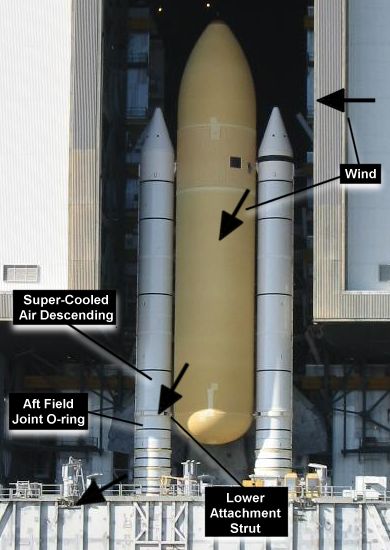
It is common procedure for ground personnel to use infrared cameras to measure the thickness of the ice that forms on the ET prior to launch. Purely by chance, the Ice Team happened to point a camera at the aft field joint of the right SRB and recorded a temperature of only 8°F (-13°C), much colder than the air temperature and far below the design tolerances of the O-rings. Had this wind been blowing in almost any other direction and not impinged on the aft field joint, it is likely that the O-rings would have been considerably warmer and the disaster may not have occurred.
An additional factor that contributed to the tragedy was that the information collected by the Ice Team was never passed on to decision makers, primarily because it was not the Ice Team's responsibility to report anything other than the ice thickness on the ET. Had the aft field joint temperature been provided to engineers at NASA and Morton Thiokol, the launch almost surely would've been aborted and the loss of Challenger avoided.
O-ring Failure:
All of the factors we have discussed so far occurred hours before the launch, but what of the flight itself? Prior to Challenger, it was thought that any failure of the SRBs would occur at the moment of ignition and result in the catastrophic loss of the entire vehicle and launch pad. On the contrary, the super-cooled O-rings of the aft field joint still performed their job well into the mission. The O-rings did partially fail at ignition as indicated by launch pad cameras showing puffs of black smoke emanating from the aft field joint on the right SRB 0.678 seconds after booster ignition. These puffs, often referred to as "blow-by," indicate that the joint was not completely sealed, and hot exhaust gases within the booster were escaping as it eroded the rubber O-rings. Another eight additional puffs of smoke were observed from 0.836 through 2.500 seconds into the mission, as shown below, indicating further erosion of the O-rings.
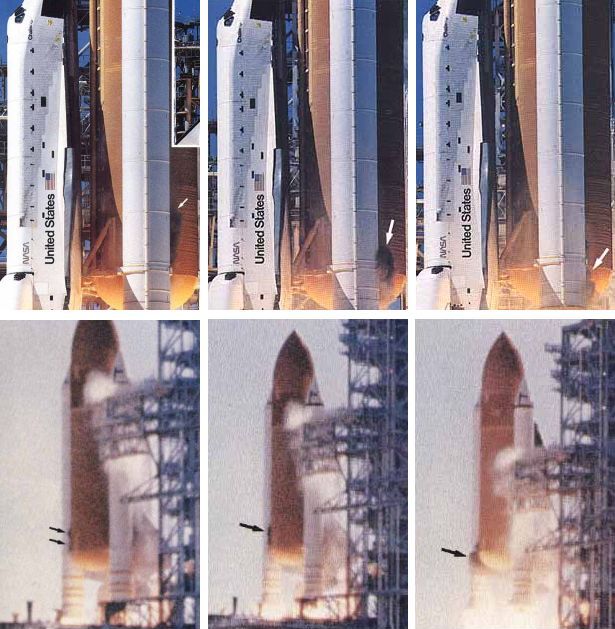
Nevertheless, no further puffs of smoke were observed since the joint apparently sealed itself. This new seal was probably due to a combination of two factors. First, the O-rings were heated by the hot burning fuel within the booster which would've increased their temperature and resiliency. This behavior is actually common in many military missiles. Such missiles often generate large clouds of black smoke at ignition due to a temporary blow-by of their O-rings that is sealed as the rings heat up. Second, the solid rocket propellant contains particles of aluminum oxide that melt when heated, and the solidifying aluminum droplets probably sealed the gap. Indeed, laboratory tests have shown that damaged O-rings with notches cut into them can be sealed by such droplets.
The temporary seal apparently remained intact for nearly one minute into the flight since the chamber pressure within the right SRB remained normal. It is very possible that this seal could have been maintained indefinitely if not for the fourth and final factor that doomed the mission. At 56 seconds after launch, right around the time of max q, Challenger passed through the worst wind shear in the history of the Shuttle program. The wind loads on the vehicle caused the booster to flex and dislodged the aluminum oxide plug that had sealed the damaged O-rings. This event was marked by a reduction in chamber pressure and the appearance of a small flickering flame that emerged from the aft field joint at 58.788 seconds Mission Elapsed Time (MET).
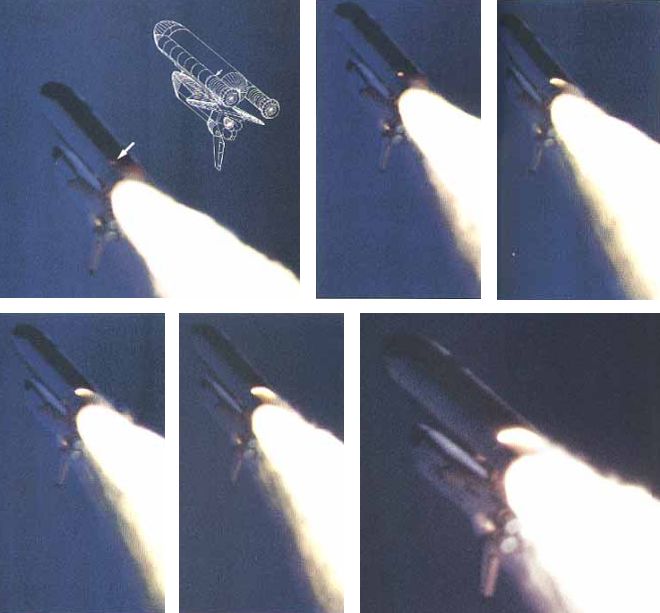
Vehicle Destruction:
The flame continued to grow and became caught up in the aerodynamic flowfield of the accelerating Shuttle. Had this flame been pointed in nearly any other direction, the Shuttle probably could have continued flying safely until booster separation, since the booster continued operating even after the rest of the vehicle had disintegrated. With the loss in chamber pressure, however, the booster would have produced insufficent thrust to push the Shuttle into its proper orbit, and the Orbiter would have had to make an emergency landing at one of its abort sites.
Since the flame was pointed directly towards the ET, however, it impinged on the SRB's supporting strut and the surface of the ET causing both to be serverely weakened. The liquid hydrogen tank soon began leaking resulting in a loss in pressure at 66.764 seconds MET. The leaking liquid hydrogen instantly vaporized into its gaseous state and was made visible by a cloud of vapor seen emanating from the ET. The escaping hydrogen also fed the flame from the right SRB causing it to change color and become even more pronounced at 64.660 seconds. Shortly thereafter, a bright sustained glow developed on the black-tiled underside of the Orbiter. At 70 seconds MET, a circumferential leak of hydrogen appeared about a third of the way up from the bottom of the ET indicating that the hydrogen innertank had failed and the ET was disintegrating.
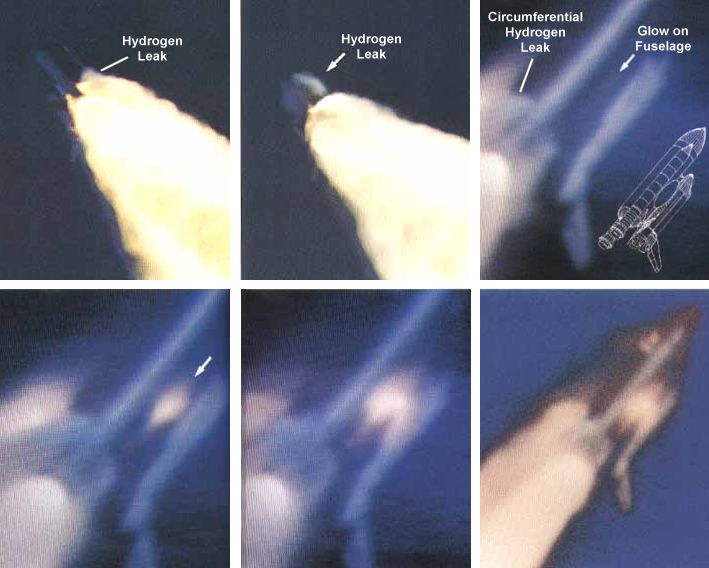
The final breakup of the vehicle began around 72 seconds when a rapid series of events was set into motion. At 72.204 seconds, the lower struct connecting the right SRB to the ET finally gave way and allowed the booster to rotate around the upper attachment strut. This rotation was indicated by a sudden change in pitch and yaw rates between the left and right boosters.
At 73.124 seconds, cameras recorded a circumferential white vapor pattern blooming from the side of the bottom dome on the ET indicating that a structural failure was in progress. This failure soon resulted in the entire aft dome of the ET dropping away from the rest of the tank to release massive amounts of liquid hydrogen. The loss of so much mass created a sudden surge in acceleration that actually pushed the hydrogen tank upward into the region separating it from the oxygen tank at the top of the ET. Simultaneously, the rotating right SRB impacted the lower part of the liquid oxygen tank causing it to fail. This collision was later confirmed when impact damage was discovered on the conical SRB nose cone after it was recovered. The failure of the oxygen tank occurred at 73.137 seconds as evidenced by white vapors appearing in the region.
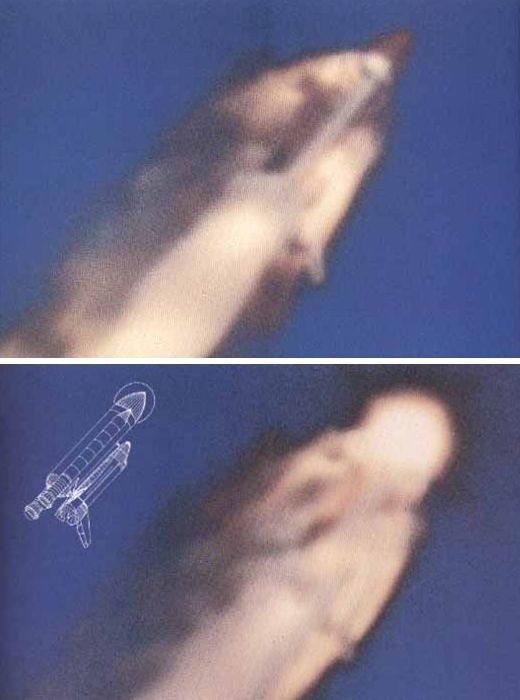
Almost immediately, this mixture of liquid oxygen and hydrogen escaping from the two ruptured tanks began burning ferociously and engulfed the entire vehicle in a cloud of explosively burning vapor. Now 76 seconds into the flight, the Shuttle was travelling Mach 1.92 at an altitude of 46,000 ft (14,035 m), equating to a speed of over 1,250 mph (2,040 km/h). The continuing rotation of the right SRB pushed the Shuttle off course such that its nose was no longer pointed in the same direction as it was flying.
This motion at such high speed put intense aerodynamic loads on the Orbiter's airframe. The stresses these loads created were simply too great for the Shuttle to bear, and it quickly broke up into several large pieces. First to fail was the forward fuselage which broke away trailing a mass of umbilical lines pulled loose from the payload bay. The nose of the Orbiter also separated from the crew cabin and spilled the hypergolic nitrogen tetroxide fuel used in the reaction control system (RCS). This fuel ignited in a reddish-brown cloud that can be seen emerging from the cloud surrounding the disintegrating Shuttle.
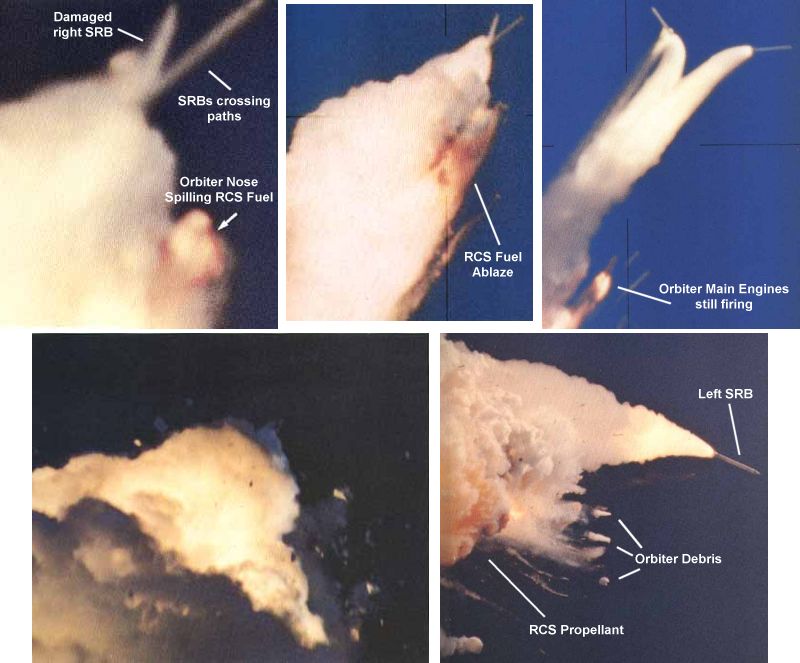
The remainder of the Orbiter, its forward end suddenly opened to the supersonic flow, blew apart from the inside out and threw up a hail of debris that emerged from the massive vapor cloud. Clearly visible in the debris raining down after the breakup were the crew cabin, left wing, and the aft fuselage containing the three main engines that were still firing using their remaining propellant. The two SRBs crossed paths and continued operating until 110 seconds after launch, when they were destroyed using onboard self-destruct explosives.
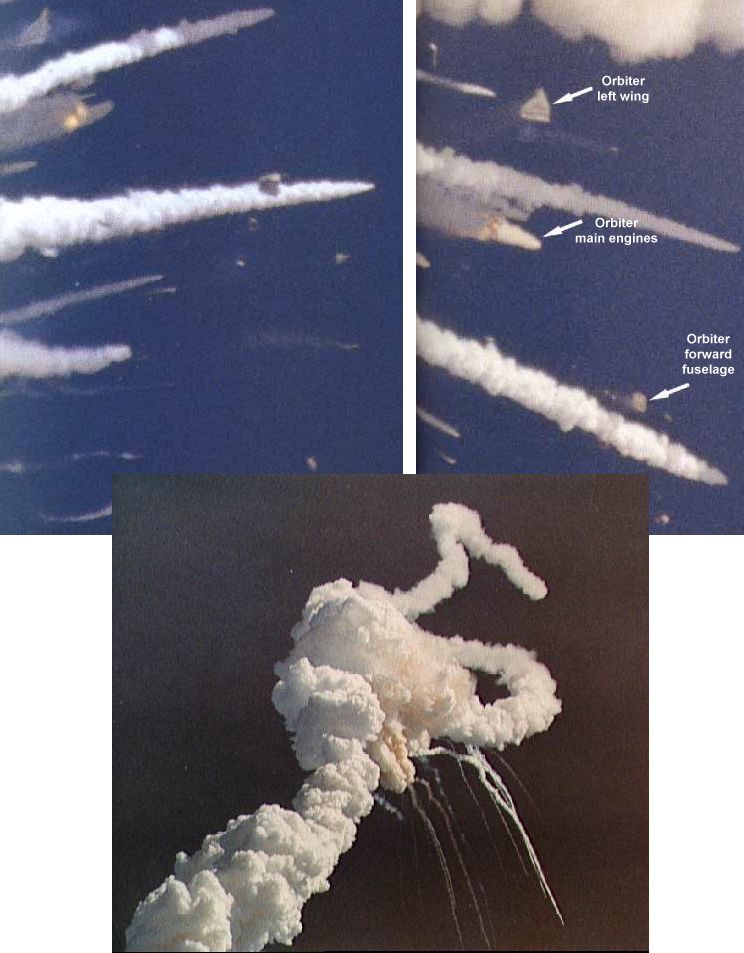
Fate of the Crew:
The momentum of the crew cabin, containing the seven astronauts, carried it upward to an altitude of about 64,000 ft (19,525 m) before it began a ballistic free-fall into the ocean. While it is not conclusively known what happened to the crew during this period, it is believed that they probably survived the initial breakup of the Challenger since the loads experienced were only greater than 4 g's for a very brief period. However, the cabin did lose electrical power and oxygen as it separated from the rest of the vehicle. If the cabin was depressurized during this period, it is likely that the crew was knocked unconscious due to lack of oxygen. However, the astronauts were equipped with Personal Egress Air Packs (PEAPs) containing an emergency air supply. Of the four PEAPs recovered, three had been activated and partially used indicating that at least some of the crew survived long enough to turn them on. Nevertheless, these PEAPs were not designed for high-altitude use and would not have prevented the astronauts from passing out had the cabin depressurized. Whether they were conscious throughout the descent or not, the cabin impacted the surface of the ocean at 200 mph (320 km/h), creating a force of about 200 g's that would have killed any survivors instantly.
Conclusion:
The aftermath of the Challenger disaster brought about an intensive investigation by the Presidential Commission on the Space Shuttle Challenger Accident. Led by William Rogers, the committee included such well-known members as Neil Armstrong, Sally Ride, and Chuck Yeager. The investigation uncovered a number of troubling facts about the Shuttle program, including design flaws, mismanagement, poor communications within NASA and with contractors, and inadequate safety procedures. Most obvious of the changes to come out of the investigation were a redesign of the SRB O-ring joint seals, addition of a crew escape system, and greater restrictions on conditions in which the Shuttle can be launched. A complete copy of the Rogers Commission report and its recommendations can be found at the NASA History site.
These measures proved effective until 2003 when the Columbia was lost in the second major disaster of the Shuttle
program. While there is by no means any direct link between these two accidents, it is interesting to note that
one of the key factors in the Challenger disaster was the worst wind shear ever experienced by a Shuttle, and
Columbia happened to experience the second worst wind shear in history, a factor that played a key role in its
eventual loss as well.
- answer by Jeff Scott
- answer by Aaron Brown, 4 May 2003
Related Topics:
What was the worst disaster in the history of space travel?
Read More Articles:


|
Aircraft | Design | Ask Us | Shop | Search |

|
|
| About Us | Contact Us | Copyright © 1997-2023 | |||
|
|
|||